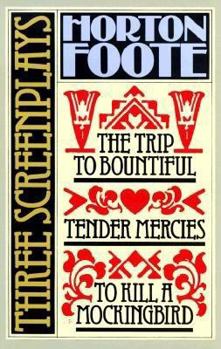Three Screenplays: To Kill a Mockingbird, Tender Mercies and the Trip to Bountiful
Select Format
Select Condition 
Book Overview
Horton Foote's uniquely personal style of screenwriting is at its peak in this collection of two Academy Award winners, To Kill a Mockingbird and Tender Mercies, and The Trip to Bountiful, a film widely named as one of 1985's best. "In an age when the lexicon of cinema is largely visual," noted Samuel G. Freedman in the New York Times Magazine, "Foote writes films. He stresses dialogue and character development rather than spectacle or even traditional narrative." Each of the three screenplays sprang from a different origin. One was adapted from the novel by Harper Lee, who later wrote, "If the integrity of a film adaptation is measured by the degree to which the novelist's intent is preserved, Mr. Foote's screenplay should be studied as a classic." Tender Mercies was conceived for the screen, and The Trip to Bountiful came from Foote's own stage and television play. While each demanded solutions to different cinematic problems, all are marked by Foote's own mastery of the screenwriting form, as well as his understanding of human relationships. All three show a modern Chekhov at work, revealing the deep currents of American society through the simplest details of daily life.
Format:Paperback
Language:English
ISBN:0802131255
ISBN13:9780802131256
Release Date:January 1994
Publisher:Grove Press
Length:240 Pages
Weight:0.60 lbs.
Dimensions:0.5" x 5.6" x 8.2"
Related Subjects
Arts, Music & Photography Drama Humor & Entertainment Movies Performing Arts ScreenwritingCustomer Reviews
2 ratings
Three screenplays by the Modern American Chekov
Published by Thriftbooks.com User , 22 years ago
I still remember watching "To Kill a Mockingbird" in the theater, absolutely stunned that the jury had convicted Tom Robinson when it was so clear, so perfectly clear and obvious to even a kid in grade school, that Atticus Finch had proved he was innocent. Horton Foote's screenplay for "To Kill a Mockingbird" is one of three collected in this volume, along with "Tender Mercies" and "The Trip to Bountiful." They represent three different types of screenwriting experiences since the first is adapted form a novel, the second from Foote's own stage play, and the third a work originally conceived as a film. Perhaps it is somewhat ironic that Foote won Oscars for the two adaptations. All three reflect Foote's emphasis on character development and dialogue rather than action and spectacle. I taught Harper Lee's novel "To Kill a Mockingbird" and screened the movie for an assignment in which students had to compare and contrast the novel with the film. Perhaps the best testament I can give to the quality fo Foote's script is that while students would always come up with favorite scenes from they book they wish had been in the film (number one choice was the hermaphrodite snowman the kids built), there was never a serious argument that Foote had left out something important. For me what stands out is how Foote picked up on one of my favorite parts of the novel, which was the nobility of Jem. The story is primarily about Scout and Atticus, not to mention Boo Radley, but it was Jem who also impressed me, and Foote captures that nobility in several key scenes. If you have a copy of the screenplay, then it is a lot easier to help students with that particular assignment, which always produces solid results.
Great Book
Published by Thriftbooks.com User , 25 years ago
This is a really great book for people who like Foote's work. If you do not especially enjoy reading Foote (or watching his plays), I would not suggest this book. The character devolopment in each of the stories is fanatical and the introductions show what was happening at the time when he wrote each play. Also, you get three plays in one book. For a Foote fan, not much could be better.






